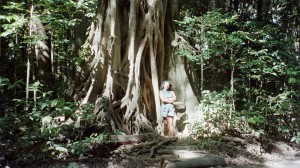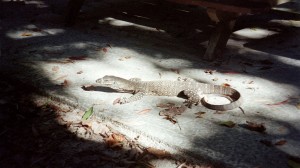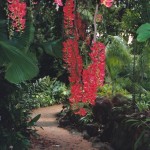
Yesterday, I talked about animal life in the region. Before we leave Cape Tribulation, I want to also discuss some unusual plant life. Notice that I’m standing in the photo to give a sense of relative size. The roots on this long-time local resident are even taller than I am. The Blue Quandon towers up to 35 yards high with a prominently buttressed base and distinctive blue fruit like large suspended figs.
Meanwhile the Stinging Tree is strictly a look-but-don’t-touch type of flora. The heart-shaped leaves have jagged edges but the real danger is the thousands of microscopic needles that embed themselves in the skin if touched. Heaven help the person who uses these leaves as a substitute for toilet paper. Unfortunately, it has been known to happen in rare instances and requires treatment at a hospital. My advise: wait and use the facilities at the next rest stop.
 Speaking of which, at a rest area, I came upon a rather large lizard, sunning himself, on the sidewalk. I didn’t approach and attempt to stand next to him for a size comparison. He was well over 3 feet long from the tip of his nose to the tip of his tail. I didn’t want him to scurry off but he seemed completely unperturbed by the presence of people. I believe he owned the place and apparently, so did he.
Speaking of which, at a rest area, I came upon a rather large lizard, sunning himself, on the sidewalk. I didn’t approach and attempt to stand next to him for a size comparison. He was well over 3 feet long from the tip of his nose to the tip of his tail. I didn’t want him to scurry off but he seemed completely unperturbed by the presence of people. I believe he owned the place and apparently, so did he.
Also, when walking through the rainforest, be wary of the wait-a-while vines hanging down from trees to the ground or gathered in clumps around the base of a tree. These are covered with small spikes that grab at clothing and can tear skin. It’s best to stay with your guide or use areas that have boardwalks built into the area for visitors.
 If you are an avid gardener, the Cairns Botanical Gardens may be just the kind of relaxed, cultivated and safe place to visit at your leisure after you return from this wildnerness. But it might all seem quite tame after our recent adventures.
If you are an avid gardener, the Cairns Botanical Gardens may be just the kind of relaxed, cultivated and safe place to visit at your leisure after you return from this wildnerness. But it might all seem quite tame after our recent adventures.
